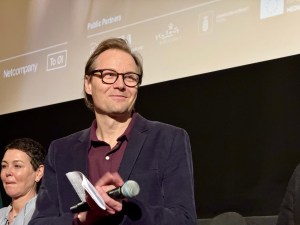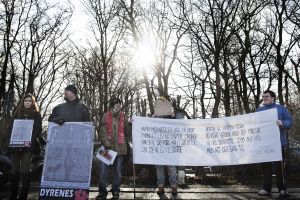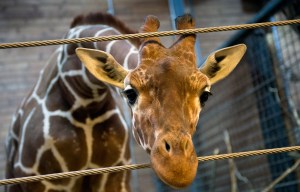The story shocked the world 10 years ago: the Copenhagen Zoo’s decision to euthanize a healthy two-year-old giraffe named Marius because they considered it a “surplus animal.” CNN reported on it. So did Le Monde in France, the U.K.’s Guardian and The Independent, and the Irish Times.
The New York Times wrote on February 9, 2014: “Marius the reticulated giraffe died at the Copenhagen Zoo on Sunday. He was 2 years old. The cause of death was a shotgun blast, and after a public autopsy, the animal, who was 11 feet 6 inches, was fed to the zoo’s lions and other big cats.”
Marius the giraffe at the Copenhagen Zoo days on February 7, 2014, before he was euthanized.
KELD NAVNTOFT/AFP via Getty Images
A decade after the death of Marius, the CPH:DOX festival in Copenhagen hosted the world premiere of Life and Other Problems, a documentary that uses the case of Marius to ponder the interconnectivity of species, and life on Earth. The film is directed by Max Kestner, who asks deep “existential questions,” the CPH:DOX program observes: “What is life? Does consciousness exist? Where does love come from? And last but not least: How does it all fit together – like, really? With curiosity and an open mind, Kestner embarks on a philosophical journey around the world to find answers to his questions.”
Among the many people interviewed in the film are Bengt Holst, the Copenhagen Zoo’s scientific director who made the decision to put down Marius, despite offers from around the world (even from Chechen strongman Ramzan Kadyrov) to adopt the animal. For Holst, it was a matter of principle. Marius’s genes were well represented in European zoos, he said, and the youngster (a two-year-old is a teenager in giraffe terms, Holst says in the documentary) had been rejected by his family because, Holst says, he was in effect taking up too many resources. If I interpreted him correctly, he believed keeping Marius alive was an unnatural act, because in the wild he would have been “selected out” in an evolutionary/Darwinian sense.

Director Max Kestner at the world premiere of ‘Life and Other Problems’
Matthew Carey
Animal rights activists accused Horst of callousness, and they inundated him with death threats. Kestner doesn’t take a prosecutorial approach in his documentary, either vis-à-vis Horst or his detractor-attackers. He wants to situate the debate in a vastly larger context. By interviewing experts in microbiology and other scientific fields, a sense emerges that we ought to consider that life amounts to a constant process of recycling and reorganizing of itself, from the level of cells on up. We’re all composed of the same materials generated by the Big Bang (to amend Shakespeare, we’re not the stuff dreams are made on, but the stuff the universe is made on). Each organic creature is related to every other. The death of a single creature, by natural or unnatural means, takes on a different shading from this point of view. Why obsess over a ripple within a cosmic sea?
One expert remarks in the trailer below, “If we try to understand the world as a collection of individuals — we’re not going to get very far.”
The film made me think of an observation made by mythographer Joseph Campbell in a PBS series built around his conversations with Bill Moyers. At one point, he told Moyers that life exists by “eating and devouring itself.” Life, as a biological, thermodynamic force, requires its own substance to fuel itself. In order to live, we kill. That is why Holst fed Marius’s carcas to the lions.

Producer Vibeke Vogel (with microphone) at the world premiere of ‘Life and Other Problems’ at CPH:DOX. To her left is co-producer John Archer.
Matthew Carey
The inspiration to do a documentary on the death of Marius and that story’s larger significance came from producer Vibeke Vogel.
“I was so fascinated about the story and how, to me, it said so much about how we connect to other species,” Vogel told Deadline after the world premiere at the Grand Teatret in Copenhagen. “And it was also a very colorful story with so many interesting people who chipped in with their opinions.”
Vogel and Kestner collaborated on a previous the film, the 2004 documentary short Max by Chance (Rejsen på ophavet), which raised different philosophical questions than Life and Other Problems.
“It was all about, is it all a coincidence, life?” Vogel explained. “And now [Life and Other Problems] is like everything is connected. I think that is the beauty of this film, and I think it’s a feel-good film about how, if you go deep enough, we are the same.”

Demonstrators outside the Copenhagen Zoo on Feb. 9, 2014, the day Marius the giraffe was killed.
KASPER PALSNOV/AFP via Getty Images
Underscoring that point, the director uses lines from John Donne’s extraordinary 17th century poem”For Whom the Bell Tolls” (voiced in the film by Orson Welles): “No man is an island/Entire of itself./Each is a piece of the continent,/A part of the main… Each man’s death diminishes me, For I am involved in mankind.”
The community of living beings (not just mankind) is part of the same continent, to borrow the Donne metaphor. We are a part of unity that links humans, giraffes, chimpanzees, orcas, flowers, trees and all organic substance. That can inspire us to protect individual animals, or perhaps we should think about our collective destiny as creatures embedded in a continuum of billions of years of evolutionary time.
Life and Other Problems will debut in Danish on Thursday. DR Sales is handling international sales. The film is written and directed by Max Kestner and produced by Vibeke Vogel. The co-producers are John Archer, Axel Danielson, and Maximilien Van Aertryck.

